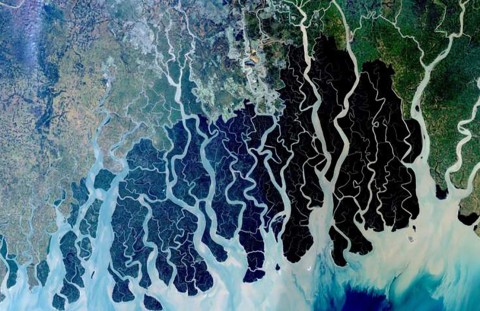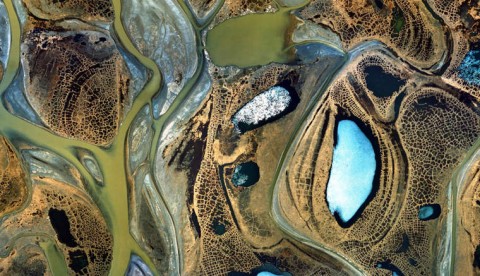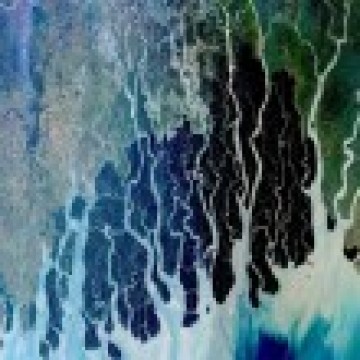How satellite imagery is transforming conservation science
Richard Conniff
Green Biz
As recently as the 1980s, gray seals effectively were extinct on Cape Cod. So when researchers announced last week that the population there has recovered not to 15,000 gray seals, the previous official estimate, but to as many as 50,000, it was dramatic evidence of how quickly conservation sometimes can work.

But the researchers, writing in the journal BioScience, weren’t just interested in the seals. They also sought to demonstrate the rapidly evolving potential of satellites to count and monitor wildlife populations and to answer big questions about the natural world. That’s still news to many wildlife ecologists, according to senior author David W. Johnston, of Duke University’s Nicholas School of the Environment. Ecologists have been slow to incorporate satellite data in their work so far, in part because their training and culture are about going into the field to get to know their study subjects first hand. The perspective from outer space has not necessarily seemed all that relevant.
But the rapidly growing abundance and sophistication of satellite imagery and remote sensing data is about to change that: "High-resolution earth imagery sources represent rich, underutilized troves of information about marine and terrestrial wildlife populations," Johnston and his co-authors write. They urge wildlife ecologists to embrace satellite imagery "as a legitimate data source that can supplement and even supplant traditional methods."
Among other promising developments, they note, satellite imagery of the Earth is being collected "globally, frequently, and at increasingly relevant resolution." It’s also becoming available in user-friendly formats thanks to a profusion of startup companies, including Planet, DigitalGlobe, Skybox Imaging (later purchased by Google and renamed Terra Bella), Urthecast and LAND INFO Worldwide Mapping.
"A University of California scientist describes the rapidly improving satellite view from outer space as a ' macroscope .'"
In February, for instance, Planet deployed 88 breadloaf-size satellites from an Indian Space Research Organisation rocket. They are now part of a 149-satellite constellation scanning every point on Earth several times a week. The primary focus is on commercial applications — for instance, tracking corn yields in Iowa, or how many cars are parked in the Walmart lot today. But the image frequency also has begun to enable rapid detection of deforestation, illegal mining and other changes in the landscape, as well as more efficient and accurate counting of wildlife populations.
NASA is also part of this trend. In 2019, it plans to launch a mission called GEDI (the Global Ecosystem Dynamics Investigation) using lidar, a laser-based remote sensing technology already familiar to ecologists for mapping 3-D vegetation structure from airplanes. This time, from the International Space Station, GEDI will enable scientists to determine the height and structure of the forest in any given location and precisely map aboveground biomass and carbon storage — all without applying for grants to hire an airplane or spending days flying transects.
GEDI also will make it possible, according to the University of Maryland’s Ralph Dubayah, principal investigator on the mission, "to estimate the net impact of deforestation and subsequent regrowth of forests, and to provide information critical for preserving and promoting habitat quality and biodiversity." The technology should prove useful for monitoring commitments made by nations under REDD (the program to reduce emissions from deforestation and forest degradation) as well as under the Paris climate accord and the Convention on Biological Diversity. In addition, it will improve weather and climate modeling and provide detailed measurement of temperate glaciers, lakes and rivers for better management of water resources.
Ecologists "are going to have this epiphany," said Johnston, as they begin to understand the potential of these new tools. It happened for him a few years ago while giving an undergraduate lecture about the movements of radio-tagged seals on Cape Cod. "We have tags on live animals, and it’s really great for students," he said. "They can check in every day on where a particular seal is traveling. I was loading data on Google Earth, and just zoomed right in to see where this seal turned up, and lo and behold, the image was good enough to count seals on the beach. I looked and said, ‘Hey, we could probably count the Cape Cod seal population this way,’ and at the end of class, three students came up to say they’d like to do that."
The seals commonly use beaches as summertime "haul-outs," and in the past, the National Oceanic and Atmospheric Administration (NOAA) has counted them in the traditional fashion, by flying over the beach and taking photographs. But NOAA never got around to publishing all the resulting data, to the frustration of other researchers, said Johnston, and it also "never worked to correct the beach count for the number of animals at sea."

Satellite images freed the researchers from dependence on the NOAA data. And data from their own long-term radio-tagging study, showing how much time seals spend typically at sea in a given day or season, allowed the researchers to develop an algorithm for calculating the total population, rather than just the part visible on the beach.
Douglas McCauley, a marine biologist at the University of California Santa Barbara, praises the new study for bringing the potential of satellite-based wildlife research "home to our own backyards," on a question with major management implications. For Cape Cod vacationers feeling that a seal haul-out has crowded them off a favorite beach, or for fishermen losing their catch to seals, news that 50,000 gray seals are now on the Cape is likely to sound like an invasion.
For conservationists, on the other hand, it may not even represent recovery to the original population level. The long-running debate about the seals can become highly emotional. An accurate count is the essential starting point for deciding among such management options as keeping hands off, paying for a contraceptive darting program, authorizing nonlethal harassment or even beginning to cull seals. "This is placing satellite data front and center in wildlife management," said McCauley.
Beyond counting populations, satellites also have the potential to answer bigger wildlife behavioral questions. McCauley’s lab is using satellite data, for instance, to determine how wildebeests in the Serengeti exploit the habitat. "You can take one satellite image and you can sense the productivity — where the grass is greenest — based on reflectance patterns. And you can create a layer showing where all the wildebeests are, and see if they are tracking the productivity of the environment well."
Another overlay factors in the "landscape of risk," he said — a predator attack is more likely on the edge of a forest, or near one of the rock outcrops called kopjes, or at a watering hole. "Then you can ask how all that maps onto the migration corridor" to understand the importance of protected areas, especially in the face of increasing human development. Over the years, McCauley’s team and collaborators at the University of Glasgow have tracked several dozen wildebeests using radio collars. "This year, we don’t want to track two more," he said. "We want to track 200,000" via satellite.
McCauley describes the rapidly improving view from outer space as "a macroscope." It also should be a major boost for dwindling conservation program budgets, because the data is often available at no cost — and at much less risk for the researchers. In a study of U.S. biologists killed during research or management work from 1937 to 2000, two-thirds died as a result of air accidents.
"I don’t think we are ever going to get away from people in airplanes doing some biology," said Johnston. "But for things that are especially dangerous, like over the water," or in remote polar regions, satellite images are at least as good.
"For the moment, a lot of biologists have no idea what remote sensing is, how to get the data or how to use the data."
So why haven’t more wildlife researchers rushed to take advantage of satellite data? Partly because of scientific fiefdoms, said Nathalie Pettorelli of the Zoological Society of London: "Biological tradition is built on going outside and working with species. But the development of remote sensors and the use of satellite data have mainly happened in geography departments. Those two disciplines haven’t been used to working together. They don’t share common terminologies. A remote sensing expert will tell you about land cover, and a biologist will tell you about ecosystems. So you have to reconcile those viewpoints."
When Pettorelli first turned to satellite data to help determine how environmental change is affecting biodiversity and ecosystem services, biologists told her it was a bad idea. "There are people who don’t trust satellite data," she said. They consider it "competition with ground data," although in reality satellite and ground data often enhance each other, as happened with the Cape Cod seals. Meanwhile, the remote sensing experts "were telling me it’s too complex; you need to hire somebody. I didn’t have money to hire somebody, and I just learned more and more how to do it myself."
Lack of training remains an obstacle to broader reliance on satellite data, she says, "particularly in developing countries where people could get the most out of it, where there is no money for large on-the-ground studies," or for airplane surveys. "But for the moment a lot of biologists have no idea what remote sensing is, how to get the data, how to use the data."
That lack of familiarity with the nuances of satellite data is also an impediment at the global level, said Pettorelli. Under the Convention on Biological Diversity, the 196 party nations have a series of targets to achieve by 2020 for the conservation of protected areas and the protection of plant and wildlife diversity. The only way to monitor progress in a timely and economical way is by satellite, said Pettorelli. But with just three years to go, participants still haven’t even agreed on which space-based indicators to rely on. Building trust in satellite data among her fellow biologists remains a painfully slow process.
This story first appeared on: Yale Environment 360

